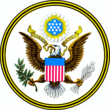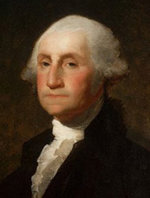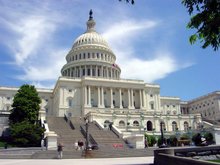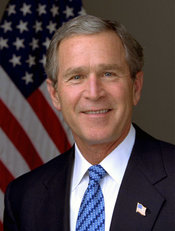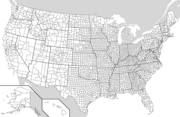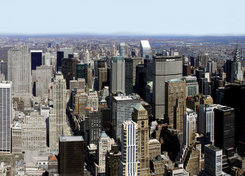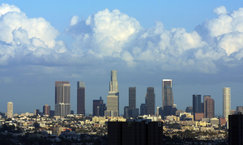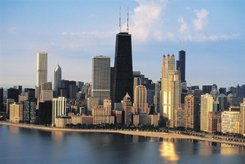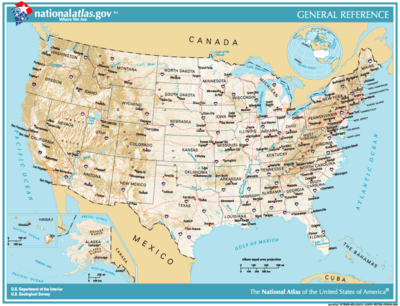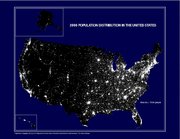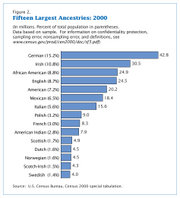United States
From Wikipedia, the free encyclopedia.
- For alternative meanings, see the disambiguation page for US, USA, or United States.
The United States of America—also referred to as the United States, the U.S., the USA, the US of A, America [1], and the States (colloquially)—is a federal republic of 50 states, located primarily in central North America.
|
|||||
| Motto: E pluribus unum (1789 to present) (Latin: "Out of Many, One") In God We Trust (1956 to present) |
|||||
| Anthem: The Star-Spangled Banner | |||||
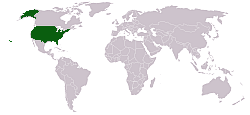 |
|||||
| Capital | Washington, D.C. |
||||
| Largest city | New York City | ||||
| Official languages | None at federal level; American English de facto |
||||
| Government | Democratic federal republic George W. Bush Dick Cheney |
||||
| Independence • Declared • Recognized Constitution |
From Great Britain July 4, 1776 September 3, 1783 |
||||
| Area • Total • Water (%) |
9,631,418 km² (3rd) 4.87% |
||||
| Population • 2005 est. • 2000 census • Density |
297,600,000 (3rd) 281,421,906 32/km² (140th) |
||||
| GDP (PPP) • Total • Per capita |
2005 estimate $12,589,600 million (1st) $42,367 (3rd) |
||||
| Currency | Dollar ($) (USD) |
||||
| Time zone • Summer (DST) |
(UTC-5 to -10) (UTC-4 to -10) |
||||
| Internet TLD | .gov .edu .mil .us .um | ||||
| Calling code | +1 |
||||
The United States has land borders with Canada and Mexico, and territorial water boundaries with Canada, Russia and the Bahamas. It is otherwise bounded by the Pacific Ocean, the Bering Sea, the Arctic Ocean, the Atlantic Ocean, the Gulf of Mexico, and the Caribbean Sea. Forty-eight of the states—often referred to as the continental, contiguous or Lower 48 states—are located in a single region between Canada and Mexico. The other two, Alaska and the archipelago of Hawaii, are not contiguous with the others. There is a federal district, the District of Columbia named 'Columbia' for the old poetic name for the country, comprising the capital, Washington, D.C. The United States also owns a number of overseas territories.
The official founding date of the United States is July 4, 1776, when the Second Continental Congress—representing thirteen British colonies—adopted the Declaration of Independence. However, the structure of the government was profoundly changed in 1788, when the states replaced the Articles of Confederation with the United States Constitution. The date on which each of the original thirteen states adopted the Constitution is typically regarded as the date that state "entered the Union" (became part of the United States). Since the mid-20th century, the United States has become the dominant global influence in economic, political, military, scientific, technological and cultural affairs.
Contents |
History
- Main articles: History of the United States, Military history of the United States, Timeline of United States history, List of U.S. military history events
American history started with the migration of people from Asia across the Bering land bridge approximately 12,000 years ago following large animals that they preyed upon into the Americas. These 'Native Americans' left evidence of their presence in petroglyphs, burial mounds, and other artifacts. It is estimated that at least ten million lived in the territory now occupied by the U.S. before European contact, and the subsequent introduction of foreign diseases such as small pox that greatly diminished the native populations. Some advanced societies were the Anasazi of the southwest, who built Chaco Canyon, and the Woodland Indians, who built Cahokia, located near present-day St Louis, a city with a population of 40,000 at its peak in 1200 AD.
During the 1500s and 1600s, the Spanish settled parts of the present-day Southwest and Florida, founding St. Augustine, Florida in 1565 and Santa Fe (in what is now New Mexico) in 1607. The first successful English settlement was at Jamestown, Virginia, also in 1607. Within the next two decades, several Dutch settlements, including New Amsterdam (the predecessor to New York City), were established in what are now the states of New York and New Jersey. In 1637, Sweden established a colony at Fort Christina (in what is now Delaware), but lost the settlement to the Dutch in 1655.
This was followed by extensive British settlement of the east coast. The British colonists remained relatively undisturbed by their home country until after the French and Indian War, when France ceded Canada and the Great Lakes region to Britain. Britain then imposed taxes on the 13 colonies, widely regarded by the colonists as unfair because they were denied representation in the British Parliament. Tensions between Britain and the colonists increased, and the thirteen colonies eventually rebelled against British rule.
In 1776, the 13 colonies split from Great Britain and formed the United States, the world's first constitutional and democratic federal republic, after their Declaration of Independence of that year, and the Revolutionary War (1775 to 1783). The original political structure was a confederation in 1777, ratified in 1781 as the Articles of Confederation. After long debate, this was supplanted by the Constitution in 1789, forming a more centralized federal government. Prior to all these was the Albany Congress in 1754, in which a union was first seriously proposed.
From early colonial times, there was a shortage of labor, which encouraged unfree labor, particularly indentured servitude and slavery. In the mid-19th century, a major division occurred in the United States over the issue of states' rights and the expansion of slavery. The northern states had become opposed to slavery, while the southern states saw it as necessary for the continued success of southern agriculture and wanted it expanded to the territories. Several federal laws were passed in an attempt to settle the dispute, including the Missouri Compromise and the Compromise of 1850. The dispute reached a crisis point in 1861, when seven southern states seceded1 from the Union and formed the Confederate States of America, leading to the Civil War. Soon after the war began, four more southern states seceded. During the war, Abraham Lincoln issued the Emancipation Proclamation, mandating the freedom of all slaves in states in rebellion, though full emancipation did not take place until after the end of the war in 1865, the dissolution of the Confederacy, and the Thirteenth Amendment took effect. The Civil War effectively ended the question of a state's right to secede, and is widely accepted as a major turning point after which the federal government became more powerful than state governments.
During the 19th century, many new states were added to the original 13 as the nation expanded across the continent. Manifest Destiny was a philosophy that encouraged westward expansion in the United States. As the population of the Eastern states grew and as a steady increase of immigrants entered the country, settlers moved steadily westward across North America. In the process, the US displaced most American Indian nations. This displacement of American Indians continues to be a matter of contention in the U.S. with many tribes attempting to assert their original claims to various lands. In some areas American Indian populations were reduced by foreign diseases contracted through contact with European settlers, and US settlers acquired those emptied lands. In other instances American Indians were removed from their traditional lands by force. The US was not a colonial power until the Spanish-American War when it acquired Puerto Rico, Guam and the Philippines. The Phillippines became independent in 1946.
During this period, the nation also became an industrial power. This continued into the 20th century, which has been termed "the American Century" because of the nation's overriding influence on the world. The US became a center for innovation and technological development; major technologies that America either developed or was greatly involved in improving include the telephone, television, computer, the Internet, nuclear weapons, nuclear power, aviation, and aeronautics.
In addition to the Civil War, another major traumatic experience for the nation was the Great Depression (1929 to 1941). The nation has also taken part in several major foreign wars, including World War I and World War II (in both of which the US later joined the Allies). During the Cold War, the US was a major player in the Korean War and Vietnam War, and, along with the Soviet Union, was considered one of the world's two "superpowers". With the collapse of the Soviet Union, the US emerged as the world's leading economic and military power. Beginning in the 1990s, the United States became very involved in police actions and peacekeeping, including actions in Kosovo, Haiti, Somalia and Liberia, and the first Gulf War driving Iraq out of Kuwait. After attacks on the World Trade Center and the Pentagon on September 11, 2001, the United States and other allied nations found themselves entangled in what has come to be called the "War on Terrorism." The war on terrorism includes the ongoing wars in Afganistan and the controversial Iraq war.
Government
- Main articles: Federal government of the United States, Politics of the United States
Republic and Suffrage
The United States is an example of a constitutional republic, with a government composed of and operating through a set of limited powers imposed by its design and enumerated in that design or Constitution of the United States of America. Specifically, the nation operates as a presidential democracy. There are three levels of government: federal, state, and local. Officials of each of these levels are either elected by eligible voters via secret ballot or appointed by other elected officials. Americans enjoy almost universal suffrage from the age of 18 regardless of race, sex, or wealth. Suffrage is limited, however: felons are disenfranchised and in some states former felons are likewise. Furthermore, the national representation of territories and the federal district of Washington, DC in Congress is limited: residents of the District of Columbia are subject to federal laws and federal taxes but they have no voting rights.
Federal government
The federal government is the national government, comprising the Congress (the legislative branch), the President (the executive branch), and the Supreme Court (the judicial branch). These three branches were designed to apply checks and balances on each other. The Constitution limits the powers of the federal government to defense, foreign affairs, the issuing and management of currency, the management of trade and relations between the states, and the protection of human rights. In addition to these explicitly stated powers, the federal government—with the assistance of the Supreme Court—has gradually extended these powers into such areas as welfare and education, on the basis of the "necessary and proper clause" of the Constitution. This is in contrast to the Canadian experience, in which a centralist constitution has gradually become less so over the past century.
Congress
The Congress is a bicameral law- making institution composed of the House of Representatives and the Senate, which both meet in the United States Capitol in Washington, DC. The House has 435 members, called representatives or congressmen/congresswomen, are elected by the people of a congressional district to represent that district for a term of two years. The number of districts for each state depends on its population, except that each state has at least one representative. According to the 2000 census, the districts had an average population of about 640,000 people. The Senate has 100 members, called senators, who represent whole, individual states for terms of six years. Each state is represented by two senators, regardless of population. On the same day as House elections, roughly one third of the Senate seats are contested, one each from roughly two thirds of the states on a rotational basis. The Constitution initially gave the state legislatures the power to elect senators; however, the Seventeenth Amendment transferred this role to the people.
The President
At the top of the executive branch is the President of the United States. The President and Vice President are elected as 'running mates' for four-year terms by the Electoral College, for which each state, as well as the District of Columbia, is allocated a number of seats based on its representation (or ostensible representation, in the case of D. C.) in both houses of Congress (see U.S. Electoral College). The relationship between the President and the Congress reflects that between the English monarchy and parliament at the time of the framing of the United States Constitution. Congress can legislate to constrain the President's executive power, even with respect to his or her command of the armed forces; however, this power is used only very rarely—a notable example was the constraint placed on President Richard Nixon's strategy of bombing Cambodia during the Vietnam War. The President cannot directly propose legislation, and must rely on supporters in Congress to promote his or her legislative agenda. The President's signature is required to turn congressional bills into law; in this respect, the President has the power—only occasionally used—to veto congressional legislation. Congress can override a presidential veto with a two-thirds majority vote in both houses. The ultimate power of Congress over the President is that of impeachment or removal of the elected President through a House vote, a Senate trial, and a Senate vote. The threat of using this power has had major political ramifications in the cases of Presidents Andrew Johnson, Richard Nixon, and Bill Clinton.
The President makes around 2,000 executive appointments, including members of the Cabinet and ambassadors, which must be approved by the Senate; the President can also issue executive orders and pardons, and has other Constitutional duties, among them the requirement to give a State of the Union address to Congress once a year. Although the President's constitutional role may appear to be constrained, in practice, the office carries enormous prestige that typically eclipses the power of Congress: the Presidency has justifiably been referred to as 'the most powerful office in the world'. The Vice President is first in the line of succession, and is the President of the Senate ex officio, with the ability to cast a tie-breaking vote. The members of the President's Cabinet are responsible for administering the various departments of state, including the Department of Defense, the Justice Department, and the State Department. These departments and department heads have considerable regulatory and political power, and it is they who are responsible for executing federal laws and regulations.
The Courts
The highest court in the land is the Supreme Court, which consists of nine justices. The court deals with federal and constitutional matters, and can declare legislation made at any level of the government as unconstitutional, nullifying the law and creating precedent for future law and decisions. A case may be appealed from a state court to a federal court only if there is a federal question; the supreme court of each state is the final authority on the interpretation of that state's laws and constitution. Below the Supreme Court are the courts of appeals, and below them in turn are the district courts, which are the general trial courts for federal law.
State and local governments
The state governments have the greatest influence over people's daily lives. Each state has its own written constitution and has different laws. There are sometimes great differences in law and procedure between the different states, concerning issues such as property, crime, health, and education. The highest elected official of each state is the Governor. Each state also has an elected legislature (bicameral in every state except Nebraska), whose members represent the different parts of the state. Of note is the New Hampshire legislature, which is the third-largest legislative body in the English-speaking world, and has one representative for every 3,000 people. Each state maintains its own judiciary, with the lowest level typically being county courts, and culminating in each state supreme court, though sometimes named differently. In some states, supreme and lower court justices are elected by the people; in others, they are appointed, as they are in the federal system.
The institutions that are responsible for local government are typically town, city, or county boards, making laws that affect their particular area. These laws concern issues such as traffic, the sale of alcohol, and keeping animals. The highest elected official of a town or city is usually the mayor. In New England, towns operate directly democratically, and in some states, counties have little or no power, existing only as geographic distinctions. In other areas, county governments have more power, such as to collect taxes and maintain law enforcement agencies.
Political divisions
- Main article: Political divisions of the United States
With the Declaration of Independence, the thirteen colonies proclaimed themselves to be nation states modeled after the European states of the time. Although considered as sovereigns initially, under the Articles of Confederation of 1781 they entered into a "Perpetual Union" and created a fully sovereign federal state, delegating certain powers to the national Congress, including the right to engage in diplomatic relations and to levy war, while each retaining their individual sovereignty, freedom and independence. But the national government proved too ineffective, so the administrative structure of the government was vastly reorganized with the United States Constitution of 1789. Under this new union, the continued status of the individual states as sovereign nation states fell into dispute in 1861, as several states attempted to secede from the union; in response, then-President Abraham Lincoln claimed that such secession was illegal, and the result was the American Civil War. Following the Union victory in 1865, the independent status of the individual states has not been broached again by any state, and the status of each state within the union, has been deemed by mainstream officials and academics to be settled as being subordinate to the union as a whole.
In subsequent years, the number of states grew steadily due to western expansion, the purchase of lands by the national government from other nation states, and the subdivision of existing states, resulting in the current total of 50. The states are generally divided into smaller administrative regions, including counties, cities and townships.
The United States–Canadian border is the longest undefended political boundary in the world. The US is divided into three distinct sections: the continental United States, also known as "The Lower 48"; Alaska, which is physically connected only to Canada; and the archipelago of Hawaii in the central Pacific Ocean. The United States also holds several other territories, districts and possessions, notably the federal district of the District of Columbia, which is the nation's capital, and several overseas insular areas, the most significant of which are Puerto Rico, American Samoa, Guam, Northern Mariana Islands, and the United States Virgin Islands. The Palmyra Atoll is the United States' only incorporated territory; it is unorganized and uninhabited. The United States Navy has held a base at a portion of Guantanamo Bay, Cuba since 1898. The United States government possesses a lease to this land, which only mutual agreement or United States abandonment of the area can terminate. The present Cuban government of Fidel Castro disputes this arrangement, claiming Cuba was not truly sovereign at the time of the signing. The United States argues this point moot because Cuba apparently ratified the lease post-revolution, and with full sovereignty, when it cashed one rent check in accordance with the disputed treaty.
Foreign relations and military
- Main articles: Foreign relations of the United States, Military of the United States
The immense military and economic dominance of the United States has made foreign relations an especially important topic in its politics, with considerable concern about the image of the United States throughout the world. Reactions towards the United States by other nationalities are often strong, ranging from uninhibited admiration and mimicking of all things American to anti-Americanism. US foreign policy has swung about several times over the course of its history between the poles of strict isolationism and imperialism and everywhere in between.
Three of the nation's four military branches are administered by the Department of Defense: the Army, the Navy (including the Marine Corps), and the Air Force. The Coast Guard falls under the jurisdiction of the Department of Homeland Security in peacetime, but is placed under the Department of Defense in time of war.
The combined United States armed forces consist of 1.4 million active duty personnel, along with several hundred thousand each in the Reserves and the National Guard. Military conscription ended in 1973. The United States Armed forces are considered to be the most powerful military (of any sort) on Earth and their force projection capabilities are unrivaled by any other nation, or collaboration of nations.
Largest cities
- Main article: List of cities in the United States
The United States has dozens of major cities, including 11 of the 55 global cities of all types — with three alpha global cities: New York City, Los Angeles, and Chicago. The figures expressed below are for populations within city limits. A different ranking is evident when considering U.S. metro area populations (which would also include more of the global cities), although the top three would be unchanged. Note that some cities not listed (such as New Orleans, Louisiana; Seattle, Washington; Las Vegas, Nevada; Miami, Florida; Nashville, Tennessee; Boston, Massachusetts; and Washington, D.C.) are still considered important on the basis of other factors and issues, including culture, economics, heritage and politics. The twenty largest cities, based on the United States Census Bureau's 2004 estimates, are as follows:
| # | City | Population | Region |
|---|---|---|---|
| 1. | New York City, New York | 8,104,079 | Northeast |
| 2. | Los Angeles, California | 3,845,541 | Pacific-West |
| 3. | Chicago, Illinois | 2,862,244 | Midwest |
| 4. | Houston, Texas | 2,012,626 | South-Central |
| 5. | Philadelphia, Pennsylvania | 1,470,151 | Northeast |
| 6. | Phoenix, Arizona | 1,418,041 | Southwest |
| 7. | San Diego, California | 1,263,756 | Pacific-West |
| 8. | San Antonio, Texas | 1,236,249 | South-Central |
| 9. | Dallas, Texas | 1,210,393 | South-Central |
| 10. | San José, California | 904,522 | Pacific-West |
| 11. | Detroit, Michigan | 900,198 | Midwest |
| 12. | Indianapolis, Indiana | 784,242 | Midwest |
| 13. | Jacksonville, Florida | 777,704 | Southeast |
| 14. | San Francisco, California | 744,230 | Pacific-West |
| 15. | Columbus, Ohio | 730,008 | Midwest |
| 16. | Austin, Texas | 681,804 | South-Central |
| 17. | Memphis, Tennessee | 671,929 | South |
| 18. | Baltimore, Maryland | 636,251 | Mid-Atlantic |
| 19. | Fort Worth, Texas | 603,337 | South-Central |
| 20. | Charlotte, North Carolina | 594,359 | South |
Economy
- Main article: Economy of the United States
The United States has the largest economy in the world, with a per capita GDP of $40,100. In this market-oriented economy, private individuals and business firms make most of the decisions, and the federal and state governments buy needed goods and services predominantly in the private marketplace.

The largest industry of the U.S. is now service, which employs roughly three-quarters of the U.S. work force. The United States has many natural resources, namely oil and gas, metals, as well as minerals such as gold, soda ash, and zinc. In the Agriculture industries the US is a top producers of, among others, corn, soy beans, wheat; the United States is a net exporter of food. The U.S. manufacturing sector produces, among other things, cars, airplanes, and electronics.
Economic activity varies greatly from one part of the country to another, with many industries being largely dependent on a certain city or region; New York City is the center of the American financial, publishing, broadcasting, and advertising industries; Silicon Valley is the country’s primary location for high technology companies, while Los Angeles is the most important center for film production. The Midwest is known for its reliance on manufacturing and heavy industry, with Detroit serving as the center of the American automotive industry; the Great Plains are known as “the breadbasket of America” for their tremendous agricultural output, while Texas is largely associated with the oil industry; the southeast is a major hub for medical research, as well as many of the nation's textiles manufacturers.
Several countries continue to link their currency to the dollar or even use it as a currency (such as Ecuador), although this practice has subsided since the collapse of the Bretton Woods system. Many markets are also quoted in dollars, such as oil and gold. The dollar is also the predominant reserve currency in the world, and more than half of global reserves are in dollars.
The largest trading partner of the United States is Canada (19%), China (12%) Mexico (11%), and Japan (8%). More than 50% of total trade is with these four countries.
In 2003, the United States was ranked as the third most visited tourist destination in the world; its 40.4 million visitors ranked behind France's 75 million and Spain's 52.5 million.
The USA's imports exceed exports by 80%, leading to an annual trade deficit of $700 billion, or 6% of gross domestic product. It is the largest debtor nation in the world with total gross foreign debt of over 13 trillion (2005 est) and it absorbs more than 50% of global savings annually.
Since the 1980s, the US has increased the use of neoliberal economic policies that reduce government intervention and reduce the size of the welfare state, backing away from the more interventionist Keynsian economic policies that had been in favor since the Great Depression. As a result, the United States provides fewer government-delivered social welfare services than most industrialized nations, choosing instead to keeping its tax burden lower and relying more heavily on the free market and private charities.
- See also: List of United States companies
Geography and climate
Map of the United States (PDF)
- Main article: Geography of the United States
As the world's third-largest country after Russia and Canada, with a total area of 3,718,711 square miles (9,631,418 sq km), the United States contains a considerable variety of landscape: temperate forestland and rolling hills on the east coast, mangrove in Florida, the great plains in the center of the country, the Mississippi-Missouri river system, the Great Lakes (four of the five shared with Canada), the Rocky Mountains west of the plains, deserts and temperate coastal zones west of the Rocky Mountains and temperate rain forests in the Pacific northwest. Alaska's tundra and the volcanic, tropical islands of Hawaii add to the geographic diversity.
The climate varies along with the landscape, from tropical in Hawaii and southern Florida to tundra in Alaska and atop some of the highest mountains. Most of the North and East experience a temperate continental climate, with warm summers and cold winters. Most of the American South experiences a subtropical humid climate with mild winters and long, hot, humid summers. Rainfall decreases markedly from the humid forests of the Eastern Great Plains to the semi-arid shortgrass prairies on the high plains abutting the Rocky Mountains. Arid deserts, including the Mojave, extend through the lowlands and valleys of the southwest, from westernmost Texas to California and northward throughout much of Nevada. Some parts of California have a Mediterranean climate. Rainforests line the windward mountains of the Pacific Northwest from Oregon to Alaska.
Transportation
- Main article: Transportation in the United States
Because the United States is a relatively young nation, most of the development of U.S. cities has taken place after the invention of the automobile. To link its vast territories, the United States built a network of high capacity, high speed highways, of which the most important aspect is the Interstate Highway system, commissioned in the 1950s by President Dwight D. Eisenhower and modeled after the German Autobahn. The United States also has a transcontinental rail system which is used for moving freight across the lower forty-eight states. Passenger rail service is provided by Amtrak, which serves 46 of the lower forty-eight states.
Many cities in the United States have extensive mass transit systems. New York City operates one of the world's largest and most heavily used subway systems. The regional rail and bus networks which extend into Long Island, New Jersey, Upstate New York, and Connecticut are among the most heavily used in the world.
Air travel is often preferred for destinations over 300 miles (500 km) away, and some airports, such as Hartsfield-Jackson Atlanta International Airport and Chicago's O'Hare International Airport, are among the busiest in the world. There are several major seaports in the United States, the three busiest are the Port of Los Angeles (California), Port of Long Beach (California) and Port of New York/New Jersey. Others include Houston, Texas, Charleston, South Carolina, Savannah, Georgia, Miami, Florida, Portland, Oregon, San Francisco, California, Boston, Massachusetts, Philadelphia, Pennsylvania, and Seattle, Washington, plus, outside the contiguous 48 states, Anchorage, Alaska and Honolulu, Hawaii.
Society
Demographics
- Main article: Demographics of the United States
Ethnicity and race
- Main article: Racial demographics of the United States
The United States is a very diverse country racially. According to the 2000 census, the United States has 31 ethnic groups with at least one million members each, with numerous others represented in smaller amounts.
The majority of the 295 million people currently living in the United States descend from European immigrants who have arrived since the establishment of the first colonies (most after Reconstruction). This majority, 69.1% in 2000, tends to decrease every year, and whites are expected to become a plurality within a few decades. Frequently stated European ancestries are German (15.2%), Irish (10.8%), English (8.7%), Italian (5.6%) and Scandinavian (3.7%). Many immigrants also hail from Slavic countries such as Poland and Russia. Other significant immigrant populations came from eastern and southern Europe and French Canada.
While there are few immigrants directly from Spain, Hispanics from Mexico and South and Central America are the largest minority group in the country, comprising 13.4% of the population in 2002. This has brought increasing use of the Spanish language in the United States. People of Mexican descent made up 7.3% of the population in the 2000 census, and this proportion is expected to increase significantly in the coming decades. About 12.9% (2000 census) of the American people are African Americans of non-Hispanic origin. The Asian American population (4.2%), most of whom are concentrated on the West Coast and Hawaii, is a third significant minority. The largest groups are immigrants or descendants of emigrants from the Philippines, China, India, Vietnam, South Korea and Japan.
Indigenous peoples in the United States, such as American Indians and Inuit, make up about 1.5% of the population.
- See also: Immigration to the United States
Religion
- Main articles: Religion in the United States, Demographics of the United States#Religious Affiliation
Polls estimate that 80 percent of Americans are Christians of various denominations. The other 20 percent comprises other religions such as Judaism, Islam, and Buddhism, as well as those without a specific religion.
The United States is noteworthy among developed nations for its relatively high level of religiosity. According to a 2004 Gallup poll, about 44% of Americans attend a religious service at least once a week. However, this rate is not uniform across the country; attendance is more common in the Bible Belt—composed largely of Southern and Midwestern states—than in the Northeast and West Coast. In the Southern states, Baptists are the largest group, followed by Methodists; Roman Catholics are dominant in the Northeast and in large parts of the Midwest due to their being settled by descendants of Catholic immigrants from Europe (such as Germany, Ireland, Italy, and Poland) or other parts of North America (mainly Quebec and Puerto Rico). The rest of the country for the most part has a complex mixture of various Christian groups.
Education
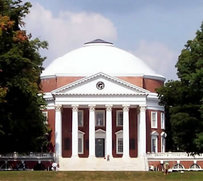
- Main article: Education in the United States
In the United States, education is a state, not federal, responsibility, and the laws and standards vary considerably. In most states, all students must attend mandatory schooling starting with kindergarten, which children normally enter at age 5, and following through 12th grade, which is normally completed at age 18 (although in some states, students are permitted to drop out upon the age of 16 with the permission of their parents/guardians). Parents may educate their own children at home (with varying degrees of state oversight), send their children to a public school, which is funded with tax money, or to a private school, where parents must pay tuition. Public schools are highly decentralized with funding and curriculum decisions taking place mostly at the local level through school boards.
After high school, students have a choice of attending either a public/state university, a private university, entering the workforce, or enlisting in the military. Public universities receive funding from the federal and state government but students still pay tuition, which can vary depending on the university, state, and whether the student is a resident of the state or not. Tuition at private universities tends to be much higher than at public universities.
American colleges and universities range from highly competitive schools, both private (such as Harvard University, Vanderbilt University, Columbia University, and Princeton University) and public (such as the University of California, Berkeley and the University of Virginia), to hundreds of high-quality local community colleges with open admission policies. There is also a subgroup of sociology/anthropology popular in American colleges and universities today called American studies.
Language
- Main article: Languages in the United States
The United States does not have an official language at federal level; nevertheless, American English is the first and/or only language of the overwhelming majority of the population and serves as the de facto official language: English is the language used for legislation, regulations, executive orders, treaties, federal court rulings, and all other official pronouncements.
Twenty-seven individual states have adopted English as their official language, and three of those—Hawaii, Louisiana, and New Mexico—have also adopted a second official language (Hawaiian, French and Spanish, respectively). Spanish follows English as the second-most spoken language in the United States, primarily due to the influence of recent Latin American immigrants and the fact that almost a fifth of its continental territory was originally part of Mexico, and it is a primary spoken language in some areas of the Southwest. Puerto Rico's first language is Spanish, and while it is a US territory and not a state its citizens have similar rights and their migration has a significant linguistic impact on New York State and other areas.
The primary signed language is American Sign Language (ASL).
As of 2004, the United States was the home of approximately 336 languages (spoken or signed), of which 176 are indigenous to U.S. territory.
Culture

- Main article: Culture of the United States
U.S. popular culture has a significant influence on the rest of the world, especially the Western world. U.S. music is heard all over the world, and it is the sire of such forms as blues and jazz and had a primary hand in the shaping of modern rock and roll and popular music culture. Many great Western classical musicians and ensembles find their home in the U.S. New York City is a hub for international operatic and instrumental music as well as the world-famed Broadway plays and musicals, Seattle is a world leader in the grunge and heavy metal music industries, and Nashville is the capital of country music. Another export of the last 20 years is Hip hop music, which is growing in influence and branching into the fashion, food and drink and movie industries. New York, Seattle, and San Francisco are worldwide leaders in graphic design and New York and Los Angeles compete with major European cities in the fashion industry.
U.S. movies (primarily embodied in Hollywood) and television shows can be seen almost anywhere except the most totalitarian places. This is in stark contrast to the early days of the republic, when the country was viewed by Europeans as an agricultural backwater with little to offer the culturally advanced world centers of Asia and Europe.
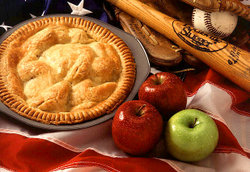
Nearing the mid-point of its third century of nationhood, the U.S. plays host to the gamut of human intellectual and artistic endeavor in nearly every major city, offering classical and popular music; historical, scientific and art research centers and museums; dance performances, musicals and plays; outdoor art projects and internationally significant architecture. This development is a result of both contributions by private philanthropists and government funding.
American holidays are variously national and local. Many holidays recognize events or people of importance to the nation's history; as such, they represent significant cultural observance.
Sports
The major team sports in America are home grown. American football, basketball, and baseball, which is often referred to as the Great American Pastime, are the top three. Ice hockey is also popular in the U.S., especially in Minnesota and the northeast states. Soccer, while the most popular sport on earth, does not have a large following in the U.S, but nevertheless, the U.S. hosted the World Cup in 1994. The majority of the world's highest paid athletes play team sports in America [2].
The United States hosts some of the premier events in other sports such as golf (including three of the four major championships), and tennis (the U.S. Open). The most popular form of auto racing is NASCAR. Formula One, while dominant in the rest of the world, has only made limited inroads into the U.S. market.
Eight Olympic Games have been hosted in the U.S., more than any other nation. The United States generally fares very well in the Olympics, especially the Summer Olympics: in 2004, the U.S. topped the medals table with 103 medals (35 gold, 39 silver and 29 bronze). For details see United States at the Olympics.
Related topics
- Main article: List of United States-related topics
International rankings
- A.T. Kearney/Foreign Policy Magazine: Globalization Index 2005, ranked 4 out of 62 countries
- IMD International: World Competitiveness Yearbook 2005, ranked 1 out of 60 economies (countries and regions)
- Reporters without borders: Third annual worldwide press freedom index (2004), ranked 22 (American territory; tied with Belgium) & 108 (in Iraq) out of 167 countries
- Save the Children: State of the World's Mothers 2005, ranked 11 out of 110 countries
- The Wall Street Journal: 2005 Index of Economic Freedom, ranked 12 out of 155 countries
- The Economist: The World in 2005 - Worldwide quality-of-life index, 2005, ranked 13 out of 111 countries
- Transparency International: Corruption Perceptions Index 2004, ranked 17 out of 146 countries (tied with Belgium and Ireland)
- United Nations Development Programme: Human Development Index 2004, ranked 8 out of 177 countries
- World Economic Forum: Global Competitiveness Report 2004-2005 - Growth Competitiveness Index Ranking, ranked 2 out of 104 countries
Notes
- ^ America may refer to the nation of the United States or to the Americas — North, Central and South America. The latter usage is more common in Latin American countries where the Spanish and Portuguese word América refers to both continents. The United States (or Estados Unidos in Spanish and Portuguese) is a less ambiguous term and less likely to cause offense. The term American meaning a citizen or national of the United States has no straightforward unambiguous synonym in English, although in Spanish it is called estadounidense. Many alternative words for American have been proposed, but none have enjoyed widespread acceptance.
External links
United States government
- White House - Official site of the U.S. President
- Senate - Official site of the United States Senate
- House - Official site of the United States House of Representatives
- Department of Motor Vehicles - Links to DMV/motor vehicles information for all of the United States
- Supreme Court - Official site of the Supreme Court of the United States
- United States - Links to official United States sites
- CIA World Factbook Entry for United States
- Official website of the United States government - Gateway to governmental sites
- Portrait of the USA - Published by the United States Information Agency, September 1997.
- The National Atlas of the United States.
- United States
- U.S. Census Housing and Economic Statistics Updated regularly by U.S. Bureau of the Census.
- U.S. Census POPClock Projection of current U.S. population
- WWW-VL: United States History Index
Other
- Historical Documents
- Info links for each state
- National Motto: History and Constitutionality
- Reference: U.S. specific web resources sorted by state
- U.S. Newspapers by State
- Schema-root.org: United States government - 1080 US government topics, each with a current news feed
Further reading
- Johnson, Paul M. A History of the American People, Perennial, 1999. ISBN 0060930349
- Zinn, Howard. A People's History of the United States, Perennial, 2003. ISBN 0060528370
| Geographic regions of the United States |
|---|
| Central | Coastal States | Deep South | East | East Coast | Gulf Coast | Mid-Atlantic | Midwest Mountain States | New England | North | Northeast | Northwest | Pacific | South | South Atlantic South Central | Southeast | Southwest | Upper Midwest | West | West Coast |
| Multinational regions: Border States | Great Lakes | Great Plains | Pacific Northwest |
| International ties of the United States | ||
|---|---|---|
| Geographical and geopolitical: Continent of Europe | European Union | ||
| Historical and cultural: Former European colony | ||
| International organizations: United Nations | UN Security Council (permanent member) | NATO | World Trade Organization | OECD | OSCE | NAFTA | Group of 8 | ||

